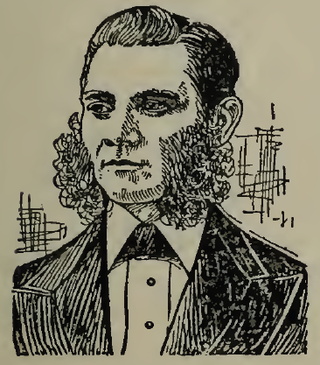
Friedrich Conrad Dietrich Wyneken was a missionary pastor in the United States. He also served for fourteen years as the second president of the Lutheran Church–Missouri Synod, and helped found Concordia Theological Seminary.

Jacob Albright was an American Christian leader, founder of Albright's People which was officially named the Evangelical Association in 1816. This church as a denomination is still in existence, headquartered in Myerstown, Pennsylvania.

Rev. N. Samuel of Tranquebar was a professor in divinity, pastor in the Tamil Evangelical Lutheran Church (T.E.L.C.), and a hymnodist. He was a famous poet and author of many books. He was also the first member of the Leipzig Evangelical Lutheran Mission (L.E.L.M.) Council.
Matthias Loy was an American Lutheran theologian in the Evangelical Lutheran Joint Synod of Ohio. Loy was a prominent pastor, editor, author and hymnist who served as president of Capital University, Columbus, Ohio.

John Christian Frederick Heyer was the first missionary sent abroad by Lutherans in the United States. He founded the Guntur Mission in Andhra Pradesh, India. "Father Heyer" is commemorated as a missionary in the Calendar of Saints of the Lutheran Church on November 7, along with Bartholomaeus Ziegenbalg and Ludwig Ingwer Nommensen.

Paul Henkel was a native of North Carolina who became an itinerant evangelist for the Lutheran Church in the eastern United States.

The Norwegian Lutheran Church in the United States is a general term to describe the Lutheran church tradition developed within the United States by immigrants from Norway.
The Evangelical Lutheran Tennessee Synod (1820–1920), commonly known as just the Tennessee Synod, was a Lutheran church body known for its staunch adherence to the Augsburg Confession and commitment to confessional Lutheranism. The synod began with six ministers in 1820 and had forty by 1919, plus ten students and candidates for ministry. It merged into the United Synod of North Carolina in 1920.

Abel J. Brown (1817–1894), was a Lutheran pastor of Immanuel's and Buehler's congregations in Sullivan County, Tennessee. He was a leader in the Evangelical Lutheran Tennessee Synod from 1836 to 1861. He was instrumental in the leading the East Tennessee congregations to form the Evangelical Lutheran Holston Synod, and was a leading member of that synod from 1861 until his death. He published several of his sermons and essays, and was the president of the Diet of Salisbury in 1884, which oversaw the creation of the United Synod of the Evangelical Lutheran Church in the South.
Methodist views on the ordination of women in the rite of holy orders are diverse.

Clement Moore Butler (1810–1890) was an Episcopal priest, author, and seminary professor who served as Chaplain of the Senate from 1850 to 1853.

Basil Manly Sr. was an American planter, preacher and chaplain best known as the author of the Alabama Resolutions, which formed part of the argument for creation of the Southern Baptist Convention on proslavery grounds.

Johann Konrad Wilhelm Löhe was a pastor of the Lutheran Church, Confesional Lutheran writer, and is often regarded as being a founder of the deaconess movement in Lutheranism and a founding sponsor of the Lutheran Church–Missouri Synod (LCMS). From the small town of Neuendettelsau, he sent pastors to North America, Australia, New Guinea, Brazil, and Ukraine. His work for a clear confessional basis within the Bavarian church sometimes led to conflict with the ecclesiastical bureaucracy. His chief concern was that a parish find its life in the eucharist, and from that source evangelism and social ministries would flow. Many Lutheran congregations in Michigan, Ohio, and Iowa were either founded or influenced by missionaries sent by Löhe. He is commemorated on 2 January by the calendars of both the LCMS and the Evangelical Lutheran Church in America.

Mount Calvary Lutheran Church, also known as Hawksbill Church, Hacksbill Church, Hoxbiehl Church, and Gomer's Church, is an historic Lutheran church with adjacent cemetery located near the town of Luray in Page County, Virginia, United States.

Hebron Church is a mid-19th-century Lutheran church in Intermont, Hampshire County, in the U.S. state of West Virginia. Hebron Church was founded in 1786 by German settlers in the Cacapon River Valley, making it the first Lutheran church west of the Shenandoah Valley. The congregation worshiped in a log church, which initially served both Lutheran and Reformed denominations. Its congregation was originally German-speaking; the church's documents and religious services were in German until 1821, when records and sermons transitioned to English.
Anthony Jacob Henckel was a German theologian who founded the first Lutheran church in North America upon his immigration from Germany to Philadelphia's Germantown neighborhood.

Concordia College was a Lutheran college and high school in Conover, North Carolina. Founded as a high school by members of the Evangelical Lutheran Tennessee Synod in 1878, it added college courses in 1881. The English Evangelical Lutheran Synod of Missouri and Other States took over control of the school in 1893. Control passed to the Lutheran Church–Missouri Synod when the English Synod merged with it in 1911. In April 1935, a fire destroyed the main building, and the school closed permanently at the end of the spring semester.
Peter Schmucker (1784–1860) was a Lutheran and later Methodist minister, who served congregations first in Virginia, then in Pennsylvania, Ohio, and other western states.
The Reverend John Nathaniel Stirewalt was a Lutheran minister serving in Page County, Virginia, from 1869 to 1906. He was born on February 21, 1844, in New Market, Virginia. He died on January 11, 1907, at the age of 62 years, 10 months, and 21 days, at his home near Luray, Virginia. He is buried in Green Hill Cemetery, Luray, Virginia.

Carl August Björk was a Swedish missionary preacher in the Midwestern United States. He was the founder of the Mission Friends – some of which later developed into the Evangelical Covenant Church, a Radical Pietistic Christian denomination with Lutheran roots, which he played a key role in founding. Björk served as the first president of the Swedish Evangelical Mission Covenant Synod.













